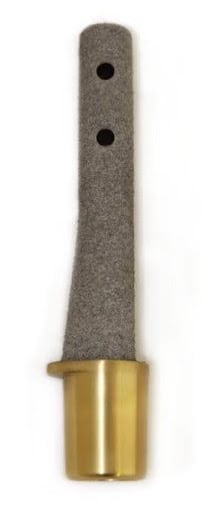Osseointegration is an advanced surgery for amputation reconstruction used for patients that are unable to tolerate a socket prosthesis due to ill fit or skin issues. Osseointegration can help patients improve their mobility and function. It can increase the feeling of where the limb is in space and may improve socket related issues like excessive sweating, skin irritation, and wounds.
Osseointegration involves a titanium implant that is surgically placed into the bone canal. The implant protrudes through the skin through an incision called an “aperture”. The implant is then able to connect directly to the prosthesis.
Prior to surgery, x-rays and CT scans are ordered and completed to provide accurate measurements for the implant that is custom fit for each patient. After the implant is manufactured, the patient undergoes surgery to insert the implant and resolve any soft tissue or nerve problems. These portions of the procedure (if needed) are either staged with multiple surgeries or performed at the same time.
The osseointegration implant that is used is the OTN BADAL X
Tibia implant

Femur Implant

Inclusion criteria:
- Above or below the knee amputation
- Difficulties with socket prosthesis
- Pain
- Socket loosening
- Recurrent skin infections
- Impaired sitting while wearing socket prosthesis
- Standing and walking restrictions due to issues with socket prosthesis
Exclusion criteria:
- Deformity of the femur or tibia
- Radiation therapy at the limb or chemotherapy within the last 18 months
- Peripheral vascular disease
- Diabetes with peripheral neuropathies
- Immunocompromised
- Cardiovascular or respiratory disorders that would restrict potential for walking
- Dementia or cognitive impairment
- Active smoking
- obesity
After the surgery, most patients stay in the hospital for 2 to 4 days. During this time, they will work with physical therapy for safe mobilization. Their pain and surgical site will be closely monitored. The total healing time of the bone into the implant (“osseointegration”) is approximately 3 months. In most cases, weight bearing or loading of the implant is initiated at 6 weeks after surgery with the use of a prosthesis. Patients continue to work with physical therapy - gradually increasing the amount of weight applied through the leg.
Risks for surgery include implant loosening, infection and fracture. The risk of fracture after a severe fall due to a fail-safe mechanism in the prosthesis that releases like ski-bindings in the event of a fall.

Aperture Site Care:
Following implantation, postoperative aperture care will begin in the hospital 1 to 2 days after surgery. Cleaning should continue at home for the first several weeks after surgery. The aperture should be cleaned twice a day – in the morning and evening. Additionally, aperture care should be performed if the area gets sweaty or soiled. Before handling the aperture site, it is important to wash your hands with soap and water or an antibacterial alcohol-based hand sanitizer. The prosthetic shrinker should be worn at all times except when performing aperture care.
Aperture care (twice a day)
- Remove the prosthetic shrinker and discard any prior dressings.
- Inspect the aperture for drainage and debris
- Gently wipe a gauze soaked with saline around the implant
- The goal is to loosen the dried drainage or debris,
- Reapply and tie an unfolded 4x4 gauze or “kling” around the aperture to collect any new drainage
- Reapply a cleaned prosthetic shrinker
You will be provided two prosthetic shrinkers. They can be hand washed if dirty from drainage.
Starting the 4th day after surgery, showering is typically allowed. Remove any dressing and allow a mild soap and water to run over the aperture and incision sites. Soaking in a bath or pool is not allowed until the incision is fully healed the aperture is fully mature. Aperture care with gauze can be done while showering. Once finished, dry the aperture and redress with a clean dressing and prosthetic shrinker.
A small amount of drainage from the aperture site is normal. Drainage can increase after a period of physical activity. If drainage does occur, wrap and tie a dry gauze around the aperture to catch any drainage. Change this dressing as needed.
At the earliest sign of skin irritation increase the cleaning to 4 times a day.
Large amounts of drainage, bleeding, or pus is not normal. If this occurs, please contact our office immediately. If you develop a fever, chills, or have worsening aperture irritation, contact our office.
Once the aperture is mature and not draining, baths and swimming may be allowed. Chlorinated pools or clean salt water is recommended over freshwater. Before swimming, a bacitracin ointment or Vaseline can be applied around the aperture site to prevent excess water and bacteria from entering the aperture site. After swimming, dry and clean the aperture site as above.
CONTACT US
(503) 850-9940
www.summitdocs.com
Office Location
4103 Mercantile Dr.
Lake Oswego, OR 97035
Office Hours
Monday - Friday 8am-4pm
IN CASE OF EMERGENCY
calls made outside office hours will
be directed to the answering service

